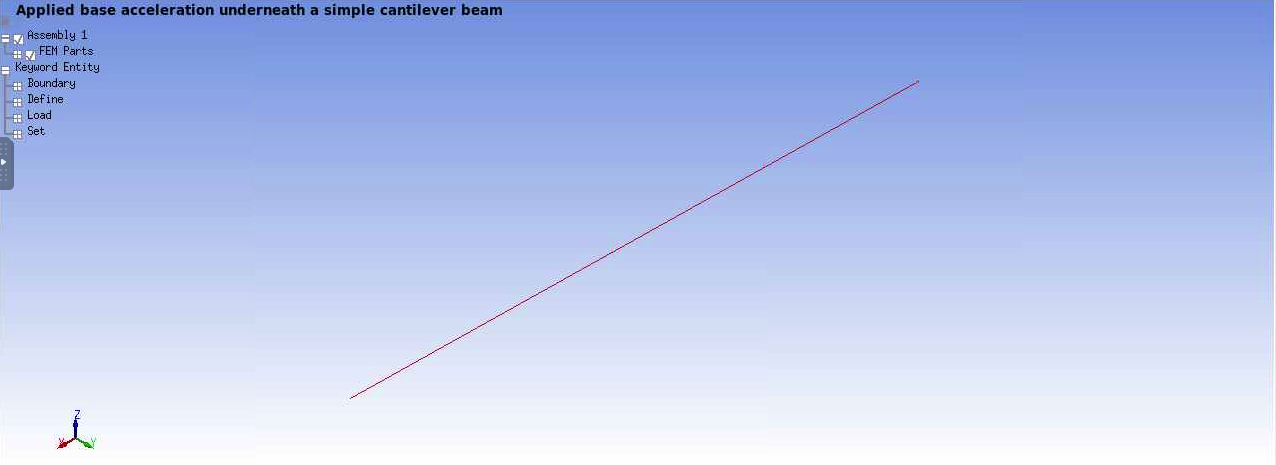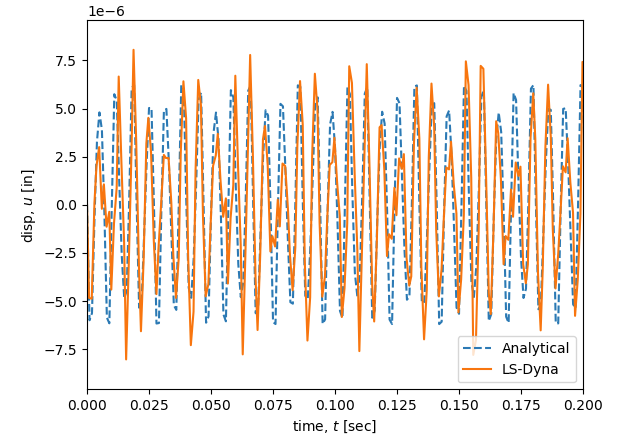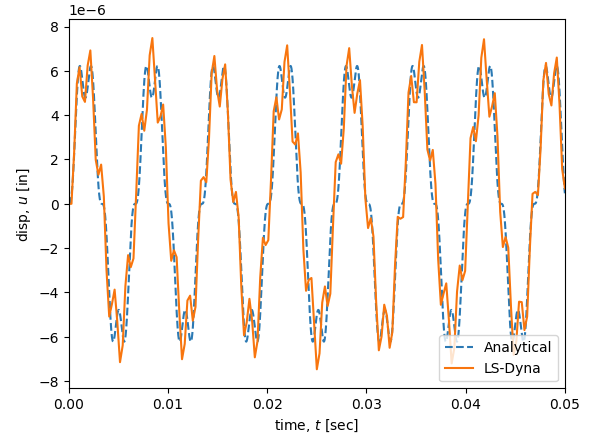TAGGED: 1d-beam, explicit-dynamics, ls-dyna, structural-dynamics
-
-
January 31, 2023 at 4:40 am
Tonmoy
SubscriberHello everyone,
I am a student working in structural dynamics using LS-Dyna and I am a novice in this software. As a starting point, I wanted to do a simple problem, which is modeling a cantilever beam as a single degree-of-freedom (SDOF) system. My plan was to verify the numerical displacement results from the free-end SDOF using available analytical procedures from dynamics book.
So far, I have modeled a single element steel beam with a square section of 6 inches by 6 inches and a length of 60 inches. The relevant keyword cards, such as *MAT_ELASTIC, *ELEMENT_BEAM, and *SECTION_BEAM, have been used to assign the material properties and geometries. I have fixed the origin node of the beam using *BOUNDARY_SPC_SET, while the other end has been left free. A snippet of my model is attached here (with the beam prism option disabled):
After modeling the beam in PrePost, I was intending to subject the beam's base to an axial ground motion (perpendicular to the cross-section of the beam, or a ground motion toward the x-direction of the beam) at the origin/far end shown here. Despite searching in various resources such as the internet, LS-Dyna manual, forums, and other instructions, I failed to find the suitable keyword card I need to apply for this. I tried to apply the *BOUNDARY_PRESCRIBED_MOTION card, but it resulted in the beam flying (not respecting the applied fixed boundary condition). I also used the *LOAD_BODY_X card, but the results obtained did not align with my analytical calculations as you can see below:
Suspecting my model I have done two other analysis with the model but both of them matches accurately (only had 0.05% error).
Hence, I would really appreciate any help or direction on what I am getting wrong here. Thanks in advance.
-
February 1, 2023 at 12:39 am
Ushnish Basu
Ansys EmployeeBase acceleration may be applied either using BOUNDARY_PRESCRIBED_MOTION_NODE with VAD=1, or using LOAD_BODY. For prescribed motion, make sure to use BOUNDARY_SPC to constrain all the other dofs, but leave the relevant dof free at the fixed base, and prescribe the motion on that dof. (In the picture, it seems that the y and z dofs are perpendicular to the beam)
For the output, make sure to give a small output time step for nodout or d3plot to capture the response in high resolution.
In general, you can find several examples here:
https://www.dynaexamples.com/introduction
-
February 2, 2023 at 5:26 pm
Tonmoy
SubscriberDear Dr. Basu,
Thank you a lot for getting back to me. I was expecting your response as, to the best of knowledge, you are an expert implementing LS-Dyna for structural applications. I have read several of your papers (on PML, which I am going to do in future) and also studied the example files you have provided in the old LSTC website. Though I did not understand much of them, but they were brilliant (much like a tutorial)!
Now, as you have suggested, I tried both the *LOAD_BODY and *BOUNDARY_PRESCRIBED on my model again. With *LOAD_BODY, after assigning DT=1E-5 in d3plot, the response I received from Dyna is quite close but not “overlapping” the analytical response. For capturing the dynamic response of the system the dt < T/10 is enough, right? In this case, the T of the beam was 0.00134 sec. Therefore, I thought the applied DT for d3plot was enough, but the results did not agree.
For the *BOUNDARY_PRESCRIBED_MOTION_NODE, I used the keywords below:
*BOUNDARY_PRESCRIBED_MOTION_NODE
1,1,1,1
*BOUNDARY_SPC_SET
1,0,0,1,1,1,1,1However, the problem of moving the whole system toward the application of the motion remains if I am using this keyword. Could you suspect what might be a cause of this behavior?
I have gone through some of the examples in the LS-Dyna Example manual and will try to replicate models from that URL you have provided me.
(You are correct that the Y and Z DOFs were perpendicular to the beam section. The model was done through a 3 node beam element with ELFORM 4 to get accurate result. Also, I have not meshed up the beam as I wanted it to act as a SDOF system and meshing it introduces a lot of DOFs in there, which I verified by doing a Eigenvalue analysis).
-
-
February 7, 2023 at 11:59 pm
Ushnish Basu
Ansys EmployeeTonmoy,
Thank you for your kind words. Please use a single type 2 beam element as that is a Timoshenko beam and has a closed-form expression for the stiffness (see the Theory Manual: LS-DYNA Theory Manual chap 6). Also, set the d3plot or nodout output timestep to the computational timestep.
-
April 7, 2023 at 12:26 am
Tonmoy
SubscriberThanks a lot Dr. Basu for your directions.
-
-
- The topic ‘Applying Base Acceleration in LS-Dyna’ is closed to new replies.



-
3912
-
1414
-
1256
-
1118
-
1015

© 2025 Copyright ANSYS, Inc. All rights reserved.










